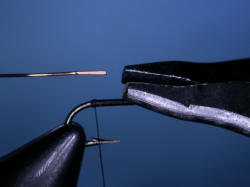|
Fly of
the Month
Bob Ireton brings together his
experience in fly fishing, aquatic entomology, and knowledge of fly
tying techniques and materials, to design and tie durable and
effective flies.
|

|

Volume 6, Issue 9
September 2005

BRASSIE
Fly, Text, and Photography by Bob Ireton
This pattern, variously described as having been developed in
Colorado, or the Southwest, is designed to imitate a western caddis
larva that make their cases from reddish sand, or sand with mica and
minerals in it. Here in our area of the Midwest, the caddis larva makes
their cases from lighter colored materials. This pattern has a body made
from copper wire, which is heavy enough to be all the weight the fly
needs to get down deep where the fish are.
MATERIALS
Hook Mustad AC3906B, or equivalent hook that is
approximately 1XL and 1XH.
Size 10-20.
Thread Black, 6/0 or 8/0.
Body Copper wire approximately the diameter of the hook wire.
Head Peacock herl.
TYING STEPS - click on
pictures for larger view
|
1 For this fly, I am using a Mustad AC3906B, size 14. This hook has a
larger barb than I would care to fish with. Although I did not mash the
barb down for the pictures, I would do so before I fished with this
hook. Now place the hook properly in the vise, and attach the working
thread behind the eye. Lay on a good base, ending above the barb. Tie a
half hitch. |
 |
|
2 Using a pair of flat jaw pliers, flatten a portion of the end of the
copper wire prior to attaching it to the hook shank. This will let the
wraps of the wire lay smoother. Dont mash too flat, or the wire might
break off when wrapped. |
 |
|
3 Lay the flattened end of the copper wire on the hook shank, and tie
in securely. Bring the thread forward, and tie a half hitch. |
 |
|
4 Wrap the copper wire forward, keeping the wraps touching each other.
Cut off the unused wire, but leave enough that you can flatten the tag
end. This will give a smoother look to the fly. Now tie down the wire,
and tie a half hitch. |
 |
|
5 Select a couple of nice strands of peacock herl. Tie them in
adjacent to the copper wire, then tie a half hitch. |
 |
|
6 Palmer the herl forward, one strand at a time. Tie in securely, and
snip off the unused peacock herl. Form a nice head with the working
thread. Tie a couple of half hitches, then a whip finish. Snip off the
thread, and apply some head cement to the head. |
 |
© 2005 Robert R. Ireton, II
Page designed by
Panfalone@fuse.net
|






